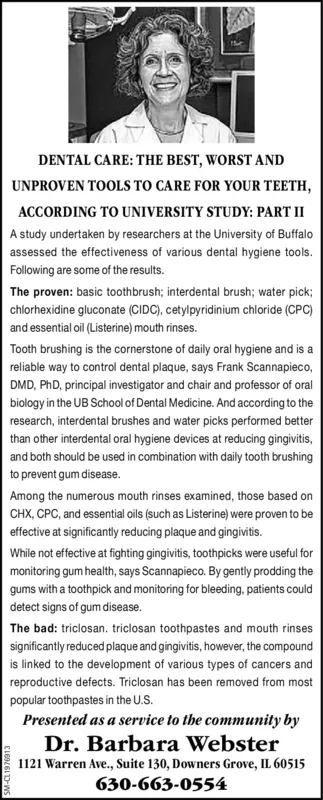Advertisement

-
Published Date
May 5, 2022This ad was originally published on this date and may contain an offer that is no longer valid. To learn more about this business and its most recent offers, click here.
Ad Text
DENTAL CARE: THE BEST, WORST AND UNPROVEN TOOLS TO CARE FOR YOUR TEETH, ACCORDING TO UNIVERSITY STUDY: PART II A study undertaken by researchers at the University of Buffalo assessed the effectiveness of various dental hygiene tools. Following are some of the results. The proven: basic toothbrush; interdental brush; water pick; chlorhexidine gluconate (CIDC), cetylpyridinium chloride (CPC) and essential oil (Listerine) mouth rinses. Tooth brushing is the cornerstone of daily oral hygiene and is a reliable way to control dental plaque, says Frank Scannapieco, DMD, PhD, principal investigator and chair and professor of oral biology in the UB School of Dental Medicine. And according to the research, interdental brushes and water picks performed better than other interdental oral hygiene devices at reducing gingivitis, and both should be used in combination with daily tooth brushing to prevent gum disease. Among the numerous mouth rinses examined, those based on CHX, CPC, and essential oils (such as Listerine) were proven to be effective at significantly reducing plaque and gingivitis. While not effective at fighting gingivitis, toothpicks were useful for monitoring gum health, says Scannapieco. By gently prodding the gums with a toothpick and monitoring for bleeding, patients could detect signs of gum disease. The bad: triclosan. triclosan toothpastes and mouth rinses significantly reduced plaque and gingivitis, however, the compound is linked to the development of various types of cancers and reproductive defects. Triclosan has been removed from most popular toothpastes in the U.S. Presented as a service to the community by Dr. Barbara Webster 1121 Warren Ave., Suite 130, Downers Grove, IL 60515 630-663-0554 DENTAL CARE: THE BEST, WORST AND UNPROVEN TOOLS TO CARE FOR YOUR TEETH, ACCORDING TO UNIVERSITY STUDY: PART II A study undertaken by researchers at the University of Buffalo assessed the effectiveness of various dental hygiene tools. Following are some of the results. The proven: basic toothbrush; interdental brush; water pick; chlorhexidine gluconate (CIDC), cetylpyridinium chloride (CPC) and essential oil (Listerine) mouth rinses. Tooth brushing is the cornerstone of daily oral hygiene and is a reliable way to control dental plaque, says Frank Scannapieco, DMD, PhD, principal investigator and chair and professor of oral biology in the UB School of Dental Medicine. And according to the research, interdental brushes and water picks performed better than other interdental oral hygiene devices at reducing gingivitis, and both should be used in combination with daily tooth brushing to prevent gum disease. Among the numerous mouth rinses examined, those based on CHX, CPC, and essential oils (such as Listerine) were proven to be effective at significantly reducing plaque and gingivitis. While not effective at fighting gingivitis, toothpicks were useful for monitoring gum health, says Scannapieco. By gently prodding the gums with a toothpick and monitoring for bleeding, patients could detect signs of gum disease. The bad: triclosan. triclosan toothpastes and mouth rinses significantly reduced plaque and gingivitis, however, the compound is linked to the development of various types of cancers and reproductive defects. Triclosan has been removed from most popular toothpastes in the U.S. Presented as a service to the community by Dr. Barbara Webster 1121 Warren Ave., Suite 130, Downers Grove, IL 60515 630-663-0554
